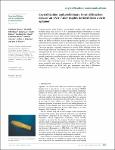Crystallization and preliminary X-ray diffraction data of an LNA 7-mer duplex derived from a ricin aptamer
Förster, Charlotte
Oberthuer, Dominik
Gao, Jiang
Eichert, André
Quast, Frederick G.
Betzel, Christian
Nitsche, Andreas
Erdmann, Volker A.
Fürste, Jens P.
Locked nucleic acids (LNAs) are modified nucleic acids which contain a modified sugar such as beta-D-2'-O,4'-C methylene-bridged ribofuranose or other sugar derivatives in LNA analogues. The beta-D-2'-O,4'-C methylene ribofuranose LNAs in particular possess high stability and melting temperatures, which makes them of interest for stabilizing the structure of different nucleic acids. Aptamers, which are DNAs or RNAs targeted against specific ligands, are candidates for substitution with LNAs in order to increase their stability. A 7-mer helix derived from the terminal part of an aptamer that was targeted against ricin was chosen. The ricin aptamer originally consisted of natural RNA building blocks and showed high affinity in ricin binding. For future stabilization of the aptamer, the terminal helix has been constructed as an ;all-locked' LNA and was successfully crystallized in order to investigate its structural properties. Optimization of crystal growth succeeded by the use of different metal salts as additives, such as CuCl(2), MgCl(2), MnCl(2), CaCl(2), CoCl(2) and ZnSO(4). Preliminary X-ray diffraction data were collected and processed to 2.8 A resolution. The LNA crystallized in space group P6(5), with unit-cell parameters a = 50.11, b = 50.11, c = 40.72 A. The crystals contained one LNA helix per asymmetric unit with a Matthews coefficient of 3.17 A(3) Da(-1), which implies a solvent content of 70.15%.
No license information

